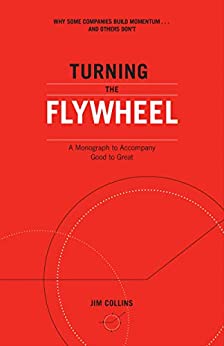More on this book
Community
Kindle Notes & Highlights
by
Jim Collins
Read between
March 1 - March 2, 2019
Every large organization will eventually have multiple sub-flywheels spinning about, each with its own nuance.
The most important thing is to keep turning the overall flywheel—and every component and sub-flywheel—with creative intensity and relentless discipline.
The big winners are those who take a flywheel from ten turns to a billion turns rather than crank through ten turns, start over with a new flywheel, push it to ten turns, only to divert energy into yet another new flywheel, then another and another.
When you reach a hundred turns on a flywheel, go for a thousand turns, then ten thousand, then a million, then ten million, and keep going until (and unless) you make a conscious decision to abandon that flywheel.
Exit definitively or renew obsessively, but never—ever—neg...
This highlight has been truncated due to consecutive passage length restrictions.
Apply your creativity and discipline to each and every turn with as much intensity as when you cranked out your first turns on the flywheel, nonst...
This highlight has been truncated due to consecutive passage length restrictions.
An overarching theme across our research findings is the role of discipline in separating the great from the mediocre.
True discipline requires the independence of mind to reject pressures to conform in ways incompatible with values, performance standards, and long-term aspirations.
The only legitimate form of discipline is self-discipline, having the inner will to do whatever it takes to create a grea...
This highlight has been truncated due to consecutive passage length restrictions.
When you combine a culture of discipline with an ethic of entrepreneurship, you create a powerful mixture that correlates with great performance.
To build an enduring great organization—whether in the business or social sectors—you need disciplined people who engage in disciplined thought and take disciplined action to produce superior results and make a distinctive impact in the world.
STAGE 1: DISCIPLINED PEOPLE LEVEL 5 LEADERSHIP Level 5 leaders display a powerful mixture of personal humility and indomitable will. They’re incredibly ambitious, but their ambition is first and foremost for the cause, for the organization and its purpose, not for themselves.
Productive change begins when you have the discipline to confront the brutal facts.
THE HEDGEHOG CONCEPT The Hedgehog Concept is a simple, crystalline concept that flows from deep understanding about the intersection of the following three circles: (1) what you’re deeply passionate about, (2) what you can be the best in the world at, and (3) what drives your economic or resource engine.
When a leadership team becomes fanatically disciplined in making decisions consistent with the three circles, they begin to generate momentum toward a good-to-great inflection.
STAGE 3: DISCIPLINED ACTION THE FLYWHEEL No matter how dramatic the end result, building a great enterprise never happens in one fell swoop. There’s no single defining action, no grand program, no one killer innovation, no solitary lucky break, no miracle moment.
Rather, the process resembles relentlessly pushing a giant, heavy flywheel, turn upon turn, building momentum until a point of breakthrough, and beyond.
To maximize the flywheel effect, you need to understand how your spe...
This highlight has been truncated due to consecutive passage length restrictions.
FIRE BULLETS, THEN CANNONBALLS The ability to scale innovation—to turn small, proven ideas (bullets) into huge successes (cannonballs)—can provide big bursts of momentum.
Then, once you have empirical validation, you fire a cannonball (concentrating resources into a big bet) on the calibrated line of sight. Calibrated cannonballs correlate with outsized results; uncalibrated cannonballs correlate with disaster.
PRESERVE THE CORE/STIMULATE PROGRESS Enduring great organizations embody a dynamic duality.


